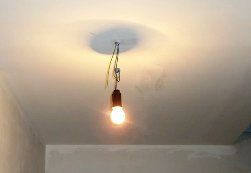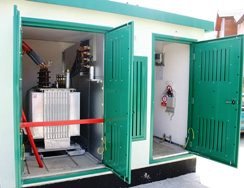Categories: Featured Articles » Electrician at home
Number of views: 33583
Comments on the article: 2
How is the supply of electricity to our homes
Electricity supply to apartment buildings and private houses.
 How many of us think about how electricity gets into our home. Remembering school physics lessons, you can draw about the following diagram:
How many of us think about how electricity gets into our home. Remembering school physics lessons, you can draw about the following diagram:
Electricity is generated at power plants, then transmitted through the high-voltage power lines (high-voltage power lines), then it gets to city and regional distribution networks.
After the RES, electricity goes to the transformer substations, where it drops to the required 380/220 Volts. And these same 380/220 volts we get in the end at home. Here we will consider the last step in more detail.
At a transformer substation, a voltage is reduced from 6kV or 10kV, depending on the transformer, to 380V / 220V. In a transformer substation, as in an ordinary transformer, there are two parts - high and low.
 In the "low part" is the subscriber part, where each consumer is allocated its own cell. Power switches, depending on the load, are installed in this cell, where fuse-links are used as protectioncircuit breakers or circuit breakers.
In the "low part" is the subscriber part, where each consumer is allocated its own cell. Power switches, depending on the load, are installed in this cell, where fuse-links are used as protectioncircuit breakers or circuit breakers.
Further, cables are laid from the transformer substation underground to the house. As a rule, lay two cables - the main and backup, in case of an accident. The house is a main switchboard (main switchboard) or ASU (input distribution device).
 The main switchboard or the switchgear are equipped with circuit breakers, from which a separate cable is laid for each staircase. Further, this cable, through the cable shaft, leads to each floor where floor distribution boards are already installed.
The main switchboard or the switchgear are equipped with circuit breakers, from which a separate cable is laid for each staircase. Further, this cable, through the cable shaft, leads to each floor where floor distribution boards are already installed.
In floor switchboards there are electricity meters, circuit breakers. Depending on the project, two or more circuit breakers are provided in the switchboard for each apartment.
Recently, many, making repairs in the apartment, make a complete replacement of wiring. For more convenient and safe operation of electrical appliances, they install their own, separate shield in the apartment, where the distribution of the entire load occurs through a larger number of machines. In this case, only a pre-registration machine of the corresponding denomination and metering device (counter).
The supply of electricity to the private sector is a bit different. If in urban conditions all communications (cables) are carried out underground, then in rural areas, in most cases, power supply to transformer substations is carried out via power lines.
High-6 (10) kV voltage is supplied to the transformers, then already low (relatively) -380 / 220V voltage goes away from the transformer through the wires to the private sector.
This is what the scheme of supplying electricity to our homes looks like.
See also at bgv.electricianexp.com
:
